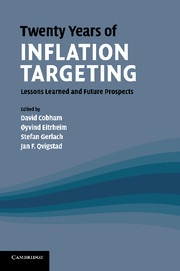Book contents
- Frontmatter
- Contents
- List of figures
- List of tables
- List of contributors
- 1 Introduction
- 2 Welcome remarks: a Norwegian perspective
- 3 Reflections on inflation targeting
- 4 Inflation targeting at twenty: achievements and challenges
- 5 Inflation targeting twenty years on: where, when, why, with what effects and what lies ahead?
- 6 How did we get to inflation targeting and where do we need to go to now? A perspective from the US experience
- 7 Inflation control around the world: why are some countries more successful than others?
- 8 Targeting inflation in Asia and the Pacific: lessons from the recent past
- 9 Inflation targeting and asset prices
- 10 The optimal monetary policy instrument, inflation versus asset price targeting, and financial stability
- 11 Expectations, deflation traps and macroeconomic policy
- 12 Heterogeneous expectations, learning and European inflation dynamics
- 13 Inflation targeting and private sector forecasts
- 14 Inflation targeting, transparency and inflation forecasts: evidence from individual forecasters
- 15 Gauging the effectiveness of quantitative forward guidance: evidence from three inflation targeters
- 16 Macro-modelling with many models
- 17 Have crisis monetary policy initiatives jeopardised central bank independence?
- 18 Inflation targeting: learning the lessons from the financial crisis
- 19 The financial crisis as an opportunity to strengthen inflation-targeting frameworks
- 20 ‘Leaning against the wind’ is fine, but will often not be enough
- 21 Inflation targeting, capital requirements and ‘leaning against the wind’: some comments
- Index
9 - Inflation targeting and asset prices
Published online by Cambridge University Press: 05 October 2010
- Frontmatter
- Contents
- List of figures
- List of tables
- List of contributors
- 1 Introduction
- 2 Welcome remarks: a Norwegian perspective
- 3 Reflections on inflation targeting
- 4 Inflation targeting at twenty: achievements and challenges
- 5 Inflation targeting twenty years on: where, when, why, with what effects and what lies ahead?
- 6 How did we get to inflation targeting and where do we need to go to now? A perspective from the US experience
- 7 Inflation control around the world: why are some countries more successful than others?
- 8 Targeting inflation in Asia and the Pacific: lessons from the recent past
- 9 Inflation targeting and asset prices
- 10 The optimal monetary policy instrument, inflation versus asset price targeting, and financial stability
- 11 Expectations, deflation traps and macroeconomic policy
- 12 Heterogeneous expectations, learning and European inflation dynamics
- 13 Inflation targeting and private sector forecasts
- 14 Inflation targeting, transparency and inflation forecasts: evidence from individual forecasters
- 15 Gauging the effectiveness of quantitative forward guidance: evidence from three inflation targeters
- 16 Macro-modelling with many models
- 17 Have crisis monetary policy initiatives jeopardised central bank independence?
- 18 Inflation targeting: learning the lessons from the financial crisis
- 19 The financial crisis as an opportunity to strengthen inflation-targeting frameworks
- 20 ‘Leaning against the wind’ is fine, but will often not be enough
- 21 Inflation targeting, capital requirements and ‘leaning against the wind’: some comments
- Index
Summary
Introduction
The framework of (flexible) inflation targeting has been widely credited with facilitating, or even causing, the ‘Great Moderation’. In public perception, hubris has now been followed by nemesis – and the inflation-targeting framework is increasingly being blamed for the current financial crisis and the world recession. Many argue that the basis of monetary policy has to change – especially in the direction of giving more weight to asset prices in setting interest rates (see, for example, Wolf 2009). Common suggestions include the idea that the interest-rate-setting authorities should ‘lean against the wind’ of asset price movements, especially in the expansionary phase of a boom (Wadhwani 2008), or that the authorities should adopt a sufficiently long horizon that they can take asset prices into account within their mandate (see, for example, Bean 2003). Others call for a much more radical recasting of the objectives and procedures of monetary policy.
This chapter argues that the debate is in serious danger of going off track. The hubris, if hubris there was, arose not in thinking that interestrate-setting policy was vastly improved, but in believing that flexible inflation targeting was (in macroeconomic policy terms) all that was needed – that other aspects of macroeconomic and prudential policy could be neglected. Clearly, the success of inflation targeting allowed the fiscal authorities to disengage from the traditional macroeconomic concerns of inflation control and stabilisation. It also allowed the regulators to concentrate on micro-regulation (as the macroeconomic consequences of regulatory failure seemed to be someone else's responsibility).
- Type
- Chapter
- Information
- Twenty Years of Inflation TargetingLessons Learned and Future Prospects, pp. 172 - 191Publisher: Cambridge University PressPrint publication year: 2010



